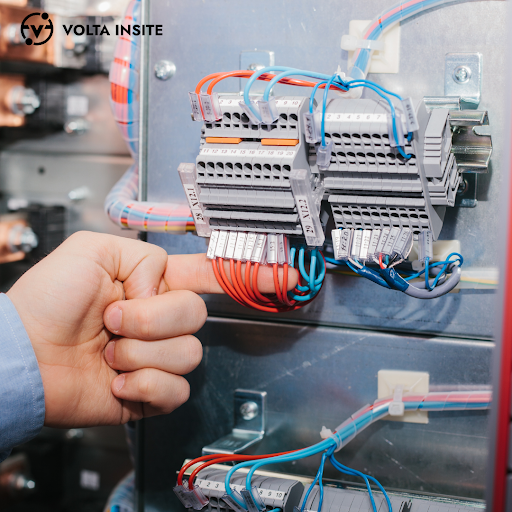
Boost Facility Performance by Identifying Power Quality Issues
 05/09/2024
05/09/2024
 Back to Articles
Back to Articles

Power quality is a critical aspect of maintaining the reliability and efficiency of any facility’s electrical system. Poor power quality can lead to equipment malfunctions, reduced lifespan of electrical components and even complete system failures. As facilities become more reliant on complex electrical systems, understanding and addressing power quality challenges has never been more crucial.
This topic was front and center at the Power Gen conference held in New Orleans earlier this year. Industry experts gathered to discuss the latest trends, technologies and challenges in power generation and distribution. One of the key takeaways was the importance of accurately identifying the origin of power quality issues. Specifically, distinguishing whether transient events, such as voltage sags or swells, are originating from the utility or are the result of internal facility problems.

The Importance of Power Quality Monitoring
Power quality refers to the stability and consistency of the electrical power supply. When power quality is compromised, it can manifest in various ways, including voltage sags, swells, transients and harmonics. These disturbances can cause significant issues, especially in facilities with sensitive electronic equipment like data centers.
Monitoring power quality is essential for several reasons:
-
Prevent equipment damage due to poor power quality which can lead to premature wear and tear, resulting in costly repairs or replacements.
-
Ensure operational efficiency by maintaining good power quality, which leads to fewer interruptions, smoother operations, and increased productivity.
-
Detect issues early to enable proactive maintenance and avoid unexpected downtime.
However, to effectively address power quality issues, it’s critical to determine whether the problem originates from the utility or within the facility itself.
Utility-Originated vs. Internally-Originated Power Quality Issues
At the Power Gen conference, a significant discussion point was the confusion many facility managers face in determining whether power quality issues are caused by the utility or by internal factors. Understanding this distinction is vital for implementing the right solutions.
Utility-Originated Issues
Power quality issues that originate from the utility are typically the result of external factors such as:
-
Fluctuations in the power grid, often due to weather events or large-scale power generation issues, that cause voltage sags, swells and transients.
-
Faults in the transmission and distribution network, such as broken lines or transformer failures, which lead to power quality disturbances that affect multiple facilities.
When a facility experiences power quality issues from the utility side, the scope of the problem is usually broader, impacting not just a single facility but potentially an entire region. While these issues are often beyond the control of individual facility managers, monitoring the mains voltage as it enters the facility is crucial. This helps in identifying whether a power quality event is occurring before the electricity reaches the internal systems.
Internally-Originated Issues
On the other hand, power quality issues originating from within a facility are usually due to:
-
Faulty electrical components that degrade over time can lead to poor connections, overheating, and ultimately result in power quality issues.
-
Overloaded circuits can cause voltage sags and other disturbances within the facility's electrical distribution system.
-
Harmonic distortion caused by the increasing use of non-linear loads such as variable frequency drives (VFDs) and switching power supplies, can introduce harmonics into the power system, leading to distortion and potential damage to equipment.
Internal power quality issues are typically localized, affecting specific areas or systems within a facility. Addressing these requires a different approach, focusing on the facility’s internal electrical infrastructure.

Monitoring Mains Voltage: The Key to Differentiating Origins
One of the most effective ways to differentiate between utility-originated and internally-originated power quality issues is by monitoring the mains voltage as it enters the facility. This involves continuously measuring the voltage levels at the point of entry to determine if any variations or disturbances are present before the power is distributed throughout the facility.
How InsiteAI Can Help
InsiteAI is designed to monitor power quality with precision which provides real-time insights into where power quality issues originate. By continuously tracking mains voltage variations, InsiteAI can pinpoint whether voltage sags, swells, or transients are coming from the utility or are the result of internal facility problems.
This distinction is crucial for taking the appropriate corrective actions. For utility-originated issues, it may involve working with the utility provider to resolve the problem. For internal issues, it enables facility managers to target specific components or systems for maintenance, ensuring that the entire electrical infrastructure remains reliable and efficient.
Understanding where power quality issues originate is the first step in resolving them. Whether the problem lies with the utility or within the facility itself, monitoring the mains voltage is essential for making informed decisions. With tools like InsiteAI, facilities can gain the insights needed to maintain high power quality, protect equipment, and ensure operational efficiency.
Stay ahead of power quality challenges by investing in comprehensive monitoring solutions, and keep your facility’s electrical systems running smoothly. Contact us today!
Additional resources:
Step-by-Step Guide to Identifying Ground Faults in VFD Systems


